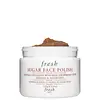What's inside
What's inside
 Key Ingredients
Key Ingredients

 Benefits
Benefits

 Concerns
Concerns

 Ingredients Side-by-side
Ingredients Side-by-side

Sucrose
HumectantPropylene Glycol Dicaprylate/Dicaprate
EmollientPEG-7 Glyceryl Cocoate
EmulsifyingStearalkonium Hectorite
Gel FormingFragaria Vesca Fruit Extract
AstringentEuphorbia Cerifera Wax
Mangifera Indica Seed Butter
Skin ConditioningPropylene Carbonate
SolventParfum
MaskingLimonene
PerfumingLimnanthes Alba Seed Oil
Skin ConditioningVitis Vinifera Seed Oil
EmollientPrunus Domestica Seed Oil
Skin ConditioningFructose
HumectantGlucose
HumectantTocopheryl Acetate
AntioxidantCaramel
Cosmetic ColorantGlycerin
HumectantWater
Skin ConditioningPotassium Sorbate
PreservativeBHT
AntioxidantCitral
PerfumingSucrose, Propylene Glycol Dicaprylate/Dicaprate, PEG-7 Glyceryl Cocoate, Stearalkonium Hectorite, Fragaria Vesca Fruit Extract, Euphorbia Cerifera Wax, Mangifera Indica Seed Butter, Propylene Carbonate, Parfum, Limonene, Limnanthes Alba Seed Oil, Vitis Vinifera Seed Oil, Prunus Domestica Seed Oil, Fructose, Glucose, Tocopheryl Acetate, Caramel, Glycerin, Water, Potassium Sorbate, BHT, Citral
Sucrose
HumectantGlycine Soja Oil
EmollientHelianthus Annuus Seed Oil
EmollientSea Salt
AbrasiveCocos Nucifera Oil
MaskingButyrospermum Parkii Butter
Skin ConditioningPolyglyceryl-3 Caprate
EmulsifyingSilica
AbrasiveCaprylic/Capric Triglyceride
MaskingTrihydroxystearin
Skin ConditioningStyrene/Butadiene Copolymer
Persea Gratissima Fruit Powder
AbrasiveLactobacillus/Punica Granatum Fruit Ferment Extract
Skin ConditioningPapain
Skin ConditioningBromelain
Skin ConditioningQuartz
AbrasiveTocopherol
AntioxidantCitric Acid
BufferingPumice
AbrasiveCaprylyl Glycol
EmollientMaltodextrin
AbsorbentPhenoxyethanol
PreservativePentaerythrityl Tetra-Di-T-Butyl Hydroxyhydrocinnamate
AntioxidantParfum
MaskingHydroxycitronellal
PerfumingLimonene
PerfumingSucrose, Glycine Soja Oil, Helianthus Annuus Seed Oil, Sea Salt, Cocos Nucifera Oil, Butyrospermum Parkii Butter, Polyglyceryl-3 Caprate, Silica, Caprylic/Capric Triglyceride, Trihydroxystearin, Styrene/Butadiene Copolymer, Persea Gratissima Fruit Powder, Lactobacillus/Punica Granatum Fruit Ferment Extract, Papain, Bromelain, Quartz, Tocopherol, Citric Acid, Pumice, Caprylyl Glycol, Maltodextrin, Phenoxyethanol, Pentaerythrityl Tetra-Di-T-Butyl Hydroxyhydrocinnamate, Parfum, Hydroxycitronellal, Limonene
Ingredients Explained
These ingredients are found in both products.
Ingredients higher up in an ingredient list are typically present in a larger amount.
Limonene is a fragrance that adds scent and taste to a formulation.
It's found in the peel oil of citrus fruits and other plants such as lavender and eucalyptus. The scent of limonene is generally described as "sweet citrus".
Limonene acts as an antioxidant, meaning it helps neutralize free radicals.
When exposed to air, oxidized limonene may sensitize the skin. Because of this, limonene is often avoided by people with sensitive skin.
The term 'fragrance' is not regulated in many countries. In many cases, it is up to the brand to define this term. For instance, many brands choose to label themselves as "fragrance-free" because they are not using synthetic fragrances. However, their products may still contain ingredients such as essential oils that are considered a fragrance.
Learn more about LimoneneParfum is a catch-all term for an ingredient or more that is used to give a scent to products.
Also called "fragrance", this ingredient can be a blend of hundreds of chemicals or plant oils. This means every product with "fragrance" or "parfum" in the ingredients list is a different mixture.
For instance, Habanolide is a proprietary trade name for a specific aroma chemical. When used as a fragrance ingredient in cosmetics, most aroma chemicals fall under the broad labeling category of “FRAGRANCE” or “PARFUM” according to EU and US regulations.
The term 'parfum' or 'fragrance' is not regulated in many countries. In many cases, it is up to the brand to define this term.
For instance, many brands choose to label themselves as "fragrance-free" because they are not using synthetic fragrances. However, their products may still contain ingredients such as essential oils that are considered a fragrance by INCI standards.
One example is Calendula flower extract. Calendula is an essential oil that still imparts a scent or 'fragrance'.
Depending on the blend, the ingredients in the mixture can cause allergies and sensitivities on the skin. Some ingredients that are known EU allergens include linalool and citronellol.
Parfum can also be used to mask or cover an unpleasant scent.
The bottom line is: not all fragrances/parfum/ingredients are created equally. If you are worried about fragrances, we recommend taking a closer look at an ingredient. And of course, we always recommend speaking with a professional.
Learn more about ParfumSucrose is a natural sugar found in fruits, vegetables, and nuts. It is the main constituent of white sugar.
In skincare, sucrose is a humectant and can be a mild exfoliant.
Sucrose is hydrophilic, meaning it attracts water. This makes it an effective humectant and helps hydrate the skin.
Studies show sugars may worsen acne-prone skin due to it disrupting the skin's natural biome. We recommend speaking with a professional if you have any concerns.
In some products such as body scrubs, sucrose is used as an gentle exfoliant.
The term 'sucrose' comes from the french word for sugar, 'sucre'.
Learn more about Sucrose